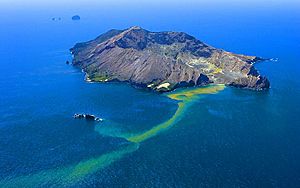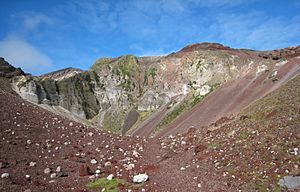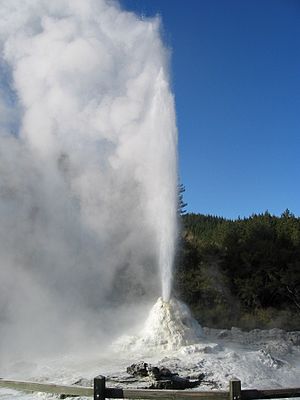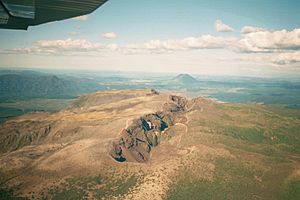Taupo Volcanic Zone facts for kids

The Taupo Volcanic Zone (TVZ) is a volcanic area in the North Island of New Zealand that has been active for the past two million years and is still highly active. Mount Ruapehu marks its south-western end and the zone runs north-eastward through the Taupo and Rotorua areas and offshore into the Bay of Plenty. It is part of the larger Central Volcanic Region that extends further westward through the western Bay of Plenty to the eastern side of the Coromandel Peninsula and has been active for four million years. The Taupo Volcanic Zone is widening east–west at the rate of about 8 mm per year. It is named after Lake Taupo, the flooded caldera of the largest volcano in the zone, the Taupo Volcano.
Contents
Activity
There are numerous volcanic vents and geothermal fields in the zone, with Mount Ruapehu, Mount Ngauruhoe and White Island erupting most frequently. The zone's largest eruption since the arrival of Europeans was that of Mount Tarawera in 1886, which killed over 100 people. Early Maori would also have been affected by the much larger Kaharoa eruption from Tarawera around 1300 AD.
The last major eruption from Lake Taupo, the Hatepe eruption, occurred in 232 AD. It is believed to have first emptied the lake then followed that feat with a pyroclastic flow that covered about 20,000 square kilometres (7,722 sq mi) of land with volcanic ash. A total of 120 km3 (29 cu mi) of material is believed to have been ejected, and over 30 km3 (7.2 cu mi) of material is estimated to have been ejected in just a few minutes. The date of this activity was previously thought to be 186AD as the ash expulsion was thought to be sufficiently large to turn the sky red over Rome and China (as documented in Hou Han Shu), but this has since been disproven.
Taupo erupted an estimated 1,170 km3 (280 cu mi) of material in its Oruanui eruption 26,500 years ago. This was Earth's most recent eruption reaching VEI-8, the highest level on the Volcanic Explosivity Index.
The Rotorua caldera has been dormant longer, with its main eruption occurring about 240,000 years ago, although lava dome extrusion has occurred within the last 25,000 years.
Extent and geological context
The Taupo Volcanic Zone is approximately 350 kilometres (217 mi) long by 50 kilometres (31 mi) wide. Mount Ruapehu marks its southwestern end, while the submarine Whakatane volcano (85 kilometres (53 mi) beyond White Island) is considered its northeastern limit.
It forms a southern portion of the active Lau-Havre-Taupo back-arc basin, which lies behind the Kermadec-Tonga subduction zone. Volcanic activity continues to the north-northeast, along the line of the Taupo Volcanic Zone, through several undersea volcanoes (known as Clark, Tangaroa, the Silents and the Rumbles), then shifts eastward to the parallel volcanic arc of the Kermadec Islands and Tonga. Although the back-arc basin continues to propagate to the southwest, with the South Wanganui Basin forming an initial back-arc basin, volcanic activity has not yet begun in this region.
South of Kaikoura the plate boundary changes to a transform boundary with oblique continental collision uplifting the Southern Alps in the South Island. A subduction zone reappears southwest of Fiordland, at the southwestern corner of the South Island, although here the subduction is in the opposite direction. Solander Island is an extinct volcano associated with this subduction zone, and the only one that protrudes above the sea.
Scientific study
Recent scientific work indicates that the Earth's crust below the Taupo Volcanic Zone may be as little as 16 kilometres thick. A film of magma 50 kilometres (30 mi) wide and 160 kilometres (100 mi) long lies 10 kilometres under the surface. The geological record indicates that some of the volcanoes in the area erupt infrequently but have large, violent and destructive eruptions when they do. There is also some possible rifting in the Taupo Volcanic Zone.
Volcanoes, lakes and geothermal fields
The following Volcanic Centers belong to the Taupo Volcanic Zone:
Rotorua, Okataina, Maroa, Taupo, Tongariro and Mangakino.
- Whakatane Graben – Bay of Plenty
- Submarine Whakatane volcano 36°48′S 177°30′E / 36.8°S 177.5°E
- Mayor Island/Tuhua 37°17′S 176°15′E / 37.283°S 176.250°E
- Whale Island 37°51′S 176°59′E / 37.850°S 176.983°E
- Whakaari/White Island 37°31′S 177°11′E / 37.52°S 177.18°E
- Te Paepae o Aotea
- Mount Edgecumbe 38°06′S 176°48′E / 38.1°S 176.8°E
- Geothermal field
- Kawerau Power Station 38°03′47″S 176°43′38″E / 38.0631°S 176.7271°E
- Rotorua Volcanic Center
- Rotorua Caldera, size: 22 km wide 38°05′S 176°16′E / 38.08°S 176.27°E
- Ngongotaha (volcano)
- Lakes
- Lake Rotorua 38°05′S 176°16′E / 38.08°S 176.27°E
- Mokoia Island 38°05′S 176°18′E / 38.083°S 176.300°E
- Lake Rotorua 38°05′S 176°16′E / 38.08°S 176.27°E
- Geothermal fields
- Tikitere/Hell's Gate
- Whakarewarewa 38°9′44″S 176°15′23″E / 38.16222°S 176.25639°E
- Pohutu Geyser
- Takeke
- Okataina Volcanic Center: The Haroharo and Tarawera complexes impounded the lakes against the outer margins of the Okataina Caldera. The Okareka Embayment and the Tarawera Volcanic Complex are inside the Haroharo Caldera which in turn is inside the Okataina Ring Structure, from Newhall (1988), but newer maps show Okataina smaller.
- Okataina Caldera, size: roughly 27 x 20 km 38°13′S 176°30′E / 38.22°S 176.5°E
- Haroharo Caldera, size: 16 x 26 km
- Haroharo volcanic complex, northern end of the Okataina Volcanic Center
- Mount Tarawera and Tarawera volcanic complex 38°13′S 176°30′E / 38.22°S 176.5°E
- Okareka vent
- Okareka Embayment
- Haroharo Caldera, size: 16 x 26 km
- Rotoma Caldera
- Lakes
- Lake Okataina 38°07′S 176°25′E / 38.117°S 176.417°E
- Lake Tarawera 38°12′S 176°27′E / 38.200°S 176.450°E
- Lake Rotokakahi (Green Lake) 38°13′S 176°20′E / 38.217°S 176.333°E
- Lake Tikitapu (Blue Lake) 38°12′S 176°20′E / 38.200°S 176.333°E
- Lake Okareka 38°10′S 176°22′E / 38.167°S 176.367°E
- Lake Rotomahana 38°16′S 176°27′E / 38.267°S 176.450°E
- Lake Rotoiti 38°02′20″S 176°25′40″E / 38.0390°S 176.4277°E
- Lake Rotoma 38°02′51″S 176°35′16″E / 38.0476°S 176.5878°E
- Lake Rotoehu 38°1′S 176°32′E / 38.017°S 176.533°E
- Geothermal fields
- Waimangu Volcanic Rift Valley 38°16′57″S 176°23′56″E / 38.28250°S 176.39889°E
- Rotoma
- Okataina Caldera, size: roughly 27 x 20 km 38°13′S 176°30′E / 38.22°S 176.5°E

- Maroa Volcanic Center: The Maroa Caldera formed in the Northeast corner of the Whakamaru Caldera, the Whakamaru Caldera partially overlaps with the Taupo Caldera on the South. The Waikato River course follows roughly the northern Maroa caldera rim on one side. The town of Whakamaru and the artificial Lake Whakamaru, on the Waikato River, have the same name too.
- Maroa Caldera, size: 16 x 25 km 38°25′S 176°05′E / 38.42°S 176.08°E
- Reporoa Caldera, size: 10 x 15 km 38°25′S 176°20′E / 38.417°S 176.333°E
- Whakamaru Caldera, size: 30 x 40 km
- Geothermal fields
- Waiotapu 38°21′34″S 176°22′11″E / 38.35944°S 176.36972°E
- Wairakei 38°37′36″S 176°06′13″E / 38.626686°S 176.103491°E
- Craters of the Moon (Karapiti)
- Orakei Korako 38°28′24″S 176°8′54″E / 38.47333°S 176.14833°E
- Ngatamariki
- Rotokaua
- Ohaaki Power Station 38°31′37″S 176°17′31″E / 38.527°S 176.292°E
- Taupo Volcanic Center
- Taupo Caldera, size: roughly 35 km wide 38°49′S 176°00′E / 38.82°S 176.00°E
- Ben Lomond rhyolite dome (contains obsidian) 38°35.7′S 175°57.2′E / 38.5950°S 175.9533°E
- Lakes
- Lake Taupo 38°49′S 176°00′E / 38.82°S 176.00°E
- Horomatangi Reefs
- Motutaiko Island
- Lake Taupo 38°49′S 176°00′E / 38.82°S 176.00°E
- Geothermal fields
- Tauhara-Taupo
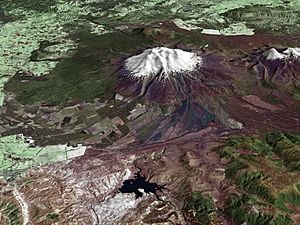
- Tongariro Volcanic Center: Lake Taupo, Kakaramea, Pihanga, Tongariro and Ruapehu are roughly aligned on the main fault.
- Kakaramea
- Pihanga 39°02′28.75″S 175°46′7″E / 39.0413194°S 175.76861°E
- Mount Tongariro and Tongariro volcanic complex 39°8′S 175°39′E / 39.133°S 175.650°E
- Mount Ngauruhoe, a main Tongariro vent 39°9′24.6″S 175°37′55.8″E / 39.156833°S 175.632167°E
- Tama crater lakes, main Tongariro vents
- Upper Tama 39°11′07″S 175°37′20″E / 39.1854°S 175.6223°E
- Lower Tama 39°12′09″S 175°36′24″E / 39.2025°S 175.6068°E
- Mount Ruapehu 39°11′S 175°21′E / 39.18°S 175.35°E
- Hauhungatahi 39°14′S 175°26′E / 39.23°S 175.44°E
- Lakes
- Lake Rotoaira 39°03′16″S 175°42′51″E / 39.0545°S 175.7143°E
- Lake Rotopounamu 39°01′36″S 175°44′18″E / 39.0267°S 175.7382°E
- Geothermal fields
- Ketetahi Springs
- Mangakino Volcanic Center: The Mangakino Volcanic Center is the westernmost and oldest rhyolitic caldera volcano in the Taupo Volcanic Zone. The course of the Waikato River crosses this area, between the artificial Lake Ohakuri (38°25′22″S 176°07′32″E / 38.42273°S 176.125474°E), the town of Mangakino (38°23′S 175°47′E / 38.383°S 175.783°E) and Hamilton (37°47′S 175°17′E / 37.783°S 175.283°E).
- Artificial Lake Maraetai
Other important features of the TVZ include the Whakatane, Ngakuru and Ruapehu grabens.
See also
 In Spanish: Zona volcánica de Taupo para niños
In Spanish: Zona volcánica de Taupo para niños




